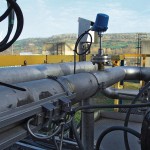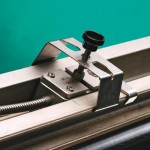Europe’s largest production facility for ammonia and nitrogen fertiliser in Sluiskil, The Netherlands, produces up to 4000 t of nitric acid per day. The filling stations are equipped with ultrasonic measuring systems to monitor and control the concentration and the mass flow.
Located in the province of Zeeland in the southwest of the Netherlands, Sluiskil has a long and distinguished history as a site for the nitrogen-processing chemical industry. Conveniently situated on the Ghent-Terneuzen Canal, the Compagnie Néerlandaise de l’Azote, the Dutch Nitrogen Company, was established here on an 80-hectare compound in the middle of the Great Depression in 1929. After extensive damages during the war and subsequent dismantling and transport to Germany, Austria and Russia, the production facilities were rebuilt in the years following 1950. In 1979, the company was acquired by the Norwegian Norsk Hydro group. When Norsk Hydro subsidiary Hydro Agri went public in 2004, the fertiliser unit was spun out under the name YARA, and the blue Yara flag still flies over the Sluiskil nitrogen plant today. In addition to two plants for urea and nitrate granulation, Yara operates three ammonia and two nitric acid plants. This makes Yara the company with the largest production capacity for ammonia and nitrate fertilisers in Europe.
Besides ammonia, nitric acid is the most important nitrogenous basic chemical compound. The two nitric acid facilities in Sluiskil have a total annual capacity of 1.4 million t. Most of the produced nitric acid is processed within the plant to make nitrogen fertilisers. Some 5 to 10 % however are sold externally. The plant has an automated filling station for transferring the nitric acid onto tank lorries. The lorry driver uses a memory chip card to enter the required quantity and concentration values into the station’s control system. The automatic filling of tank lorries requires both a concentration and mass flow measurement.
These functions are usually implemented with mass flow meters that utilise the Coriolis effect. These flow meters directly measure the mass flow and the density, which is proportional to the concentration, by means of phase shifts in the vibration of the measuring tube and changes in the resonance frequency. The lorry-filling station at Yara Sluiskil is equipped with such a Coriolis measuring system. However, nitric acid is a challenging fluid even for robust measuring methods and rugged instruments. This is particularly true if the filling process is discontinuous. Sluiskil therefore experienced frequent process disruptions and failures of the measurement systems, which had a negative impact on the performance of the plant. As a result, the production engineers at Yara started to look for alternative methods in order to ensure the continuous availability of the filling station. Quite unexpectedly, they found a solution in the field of ultrasonics.
Acoustic process analytics
Ultrasonic flow measurement with transducers clamped to the outside of pipes is a well-established technology. Particularly in the chemical industry, where aggressive and toxic fluids are often used, one likes to resort to non-invasive ultrasonic clamp-on measurement. Much less common however is the application of this technology in the field of process analysis, e.g. for concentration measurement. For flow measurement, the difference of the transit times of an ultrasonic signal in and against the direction of flow is determined and used to calculate the flow velocity. Concentration measurement on the other hand uses the signal’s transit time to determine the specific speed of sound for the fluid. The speed of sound in a fluid depends on the fluid’s adiabatic compressibility and density, and thus also on its temperature. It is a material-specific quantity. The mass flow is calculated from the volume flow and the density. Determining the actual mass flow therefore merely requires to combine these two ultrasonic measurement functions. As clamp-on transducers are not in direct contact with the fluid, ultrasonic technology is particularly suitable for the measurement of chal-lenging materials. What a simple, elegant method, the Yara engineers thought. Because of positive experiences with the Fluxus ultrasonic flow meters, the engineers presented their idea to Joost van Parreeren, the director of the Benelux branch of Flexim in Berkel en Rodenrijs.
Unlike ultrasonic volume flow measuring equipment, which can be set up to be operational in less than half an hour, concentration and mass flow measurement requires more extensive preparation. Until now, there is little data on sound velocity as a material characteristic property. It is therefore necessary to first determine a set of characteristic curves to represent the relationship between concentration and the speed of sound at various temperatures. If a good measuring effect is observed in the concentration range under consideration, the method may be deemed suitable for use in the process. Laboratory tests demonstrated that, in the relevant range of measurement, it is possible to determine the concentration of nitric acid by measuring the speed of sound. The Flexim laboratories in Berlin set to determine the characteristic concentration curves for nitric acid, and the corresponding coefficients were transferred to the Piox S transmitter. To achieve optimum representation of the nitric acid concentration curves, a special reverse algorithm was implemented in addition to the standard firmware. However, the actual installation of ultrasonic measuring equipment in the process resulted in a bitter disappointment. It almost seemed as if the effort had been in vain.
Quick temperature measurement
“The first measurement results came as a very unpleasant surprise“, recalls Joost van Parreeren. Naturally, the initial reaction was to question the accuracy and reliability of the ultrasonic technology. Joost van Parreeren however insisted: “Ultrasonic measurement is not imprecise.“ In fact, a closer inspection of the measurement series revealed that the difficulties did not originate from the sound velocity measurement: The tank plant is equipped to deliver nitric acid at various levels of concentration, with 68 % and 60 % being most common. A lower level of concentration is achieved simply by dilution with water. The diluting process is exothermic, causing the temperature of the liquid to rise. It was found that the temperature measurement was the weak point in the measuring system. The Pt 100 clamp-on probes that were initially used measure the temperature at the outer surface of the pipe. This made them unable to respond quickly enough to rapid temperature changes of the liquid. But what is the point of the most precise sound velocity measurement, if the temperature measuring device is too slow to deliver accurate values? The manufacturer of the measuring equipment advised his cus-tomers in Sluiskil to refit the measuring point with a built-in thermoelement.
The installation of a special T-type precision thermoelement proved to be successful. Given correct temperature values, the Piox S transmitter delivered correct results. Everybody at Sluiskil is delighted with an excellently adapted measuring system and the successful implementation of genuine multi-parameter measurement: At a comparatively low cost, Piox S simultaneously measures the concentration in addition to the volume and mass flow without being worn out by the aggressive fluid. Since then, Yara has equipped further measuring points with Piox S systems for the measurement of concentration and mass flow, including the tank plant for filling railway tank cars with nitric acid. There are also plans to deploy ultrasonic technology at other Yara sites.
cpp 422
Measurement technology
Vienna-Tec 2008
Share:








